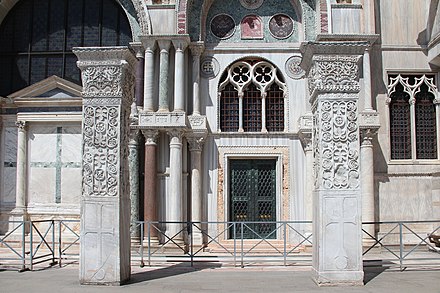In the glass-making factories of Murano, orders for coloured glass were coming
in fast and often. These glasses were remarkably thick, as they were destined to
be part of church windows. However, most orders would be shipped to Rome
Padua, Assisi, Florence and many other cities. Because, although glass was a
prime material with which Venetians created great works of art, such as pearls
and jewels, Venice had never truly adopted a great interest for church windows,
which is a little puzzling given the immense availability of fine glass, and of
churches.
Here in the Basilica, most windows are small in size, although the large Rosone
on the south wall is to be cherished for all the sunlight it allows to pour inside,
which then bounces off the mosaics that seem to light up magically.
This Rosone is however an anomaly in the Basilica, and in churches in Venice
generally. It was a feature borrowed uniquely from the famous gothic churches
in France. Many of the smaller windows around the church do not even have any
glass. Take the entrance wall facing the Square; it is adorned by metal grills or
small slabs of marble that form rather elaborated geometrical shapes. They are
still wonderfully crafted, but in the Basilica windows play a minor role. This is
because the Basilica’s outside walls were built in during the Romanic age, and
only with the passage to the Gothic age was the plainness of the walls
interrputed by a sequence of coloured glass windows.






